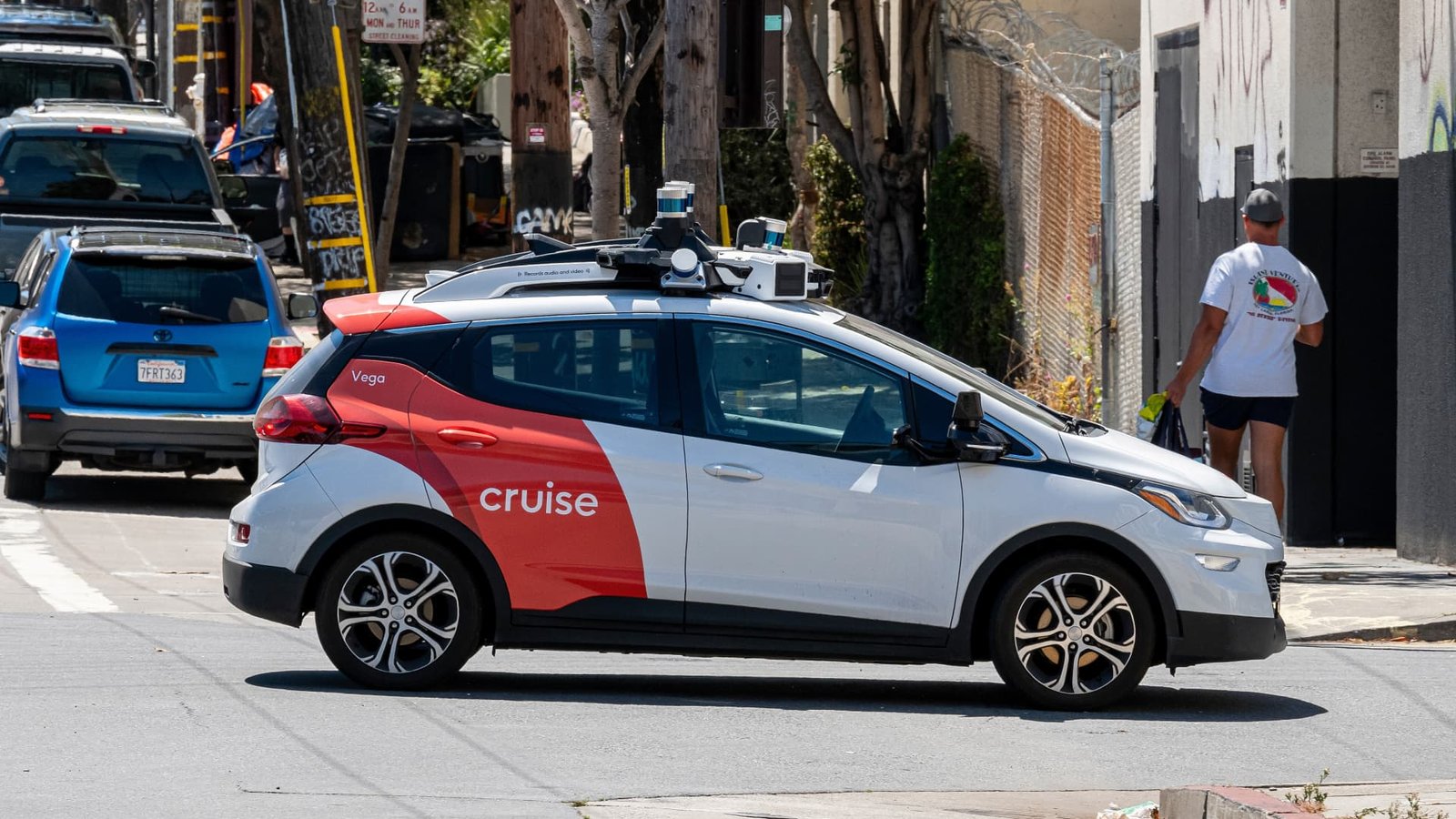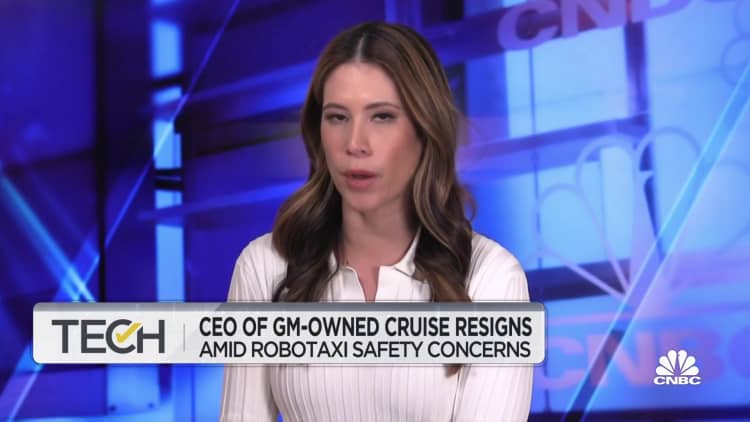Physical Address
304 North Cardinal St.
Dorchester Center, MA 02124
Physical Address
304 North Cardinal St.
Dorchester Center, MA 02124

Autonomous Cruise Taxi in San Francisco, California, USA, Thursday, August 10, 2023.
David Paul Morris | Bloomberg | Getty Images
DETROIT – For years, General Motors CEO and President Mary Barra has promised a new future for the company, away from a metal-bending automaker, to a technology-driven, forward-thinking company poised to grow.
Part of the plan was for GM’s innovation division to identify billion – yes, billion — many dollars in new market opportunities such as electric commercial vehicles, auto insurance, military defense, autonomous vehicles and even the potential for eventually “flying cars,” also known as urban air mobility.
“We are creating world-class technology solutions and services that will change the way people move, along with new fleet solutions and completely new business models,” said Barra. CES virtual conference In January 2022.
While GM has declined to disclose how much revenue such businesses have produced, Barra the end of its Cruise robotaxi operations on Tuesday, he made it clear that the automaker’s growth priorities have changed a a broader, industry-wide reduction to preserve capital. Companies including GM are now focusing on more “core” operations and adjacent business opportunities, including software, electric vehicles and “personal autonomous vehicles.”
“You really have to understand the cost of operating a robotaxi fleet, which is quite significant, and again, not our core business,” Barra said on a call with Wall Street analysts on Tuesday.
It was supposed to be a driverless ride service bright star Among GM’s growth opportunities, a few years ago executives cited the $8 trillion market opportunity the automaker would bring. That included praising former executives $50 billion in revenue by the end of this decade, and Cruise rated In more than 30 billion dollars.
Instead, after spending more than $10 billion on Cruise since its 2016 acquisition, GM is winding down the robotaxi business and rolling Cruise operations and an unspecified number of its nearly 2,300 employees into the automaker.
As part of the wind-down, GM will disclose additional spending on employee severance packages and additional spending on repurchasing equity investments from outside investors over the next year, among other things.
GM cited an increasingly competitive robotaxi market, capital allocation priorities and the significant time and resources needed to grow the business as reasons for the decision.
It was the automaker’s main competitor the alphabet-backed Waymo, which is now the last entity with significant public operations. Others, especially Teslahave an intention robotaxi businessesbut so far these operations have not been marketed.
To GM’s credit, Wall Street, which had previously encouraged growth businesses, applauded Cruise’s decision to end its robotaxi ambitions. The company’s shares were initially higher before the week ended when the announcement was made.

GM shares since December 9, 2024
GM, like other companies, has quickly shifted from trying to impress Wall Street with growth initiatives, among other things. $280 billion in new business By 2030, to refocus efforts on its core business to generate profits amid economic concerns and recession.
Analysts largely hailed GM’s decision as a positive, saving the automaker more than $1 billion in capital each year, which they hope can be put to good use. additional stock purchasesincluding a target to reduce its outstanding shares below Rs 1,000 crore.
“It has long been apparent that most investors have removed Cruise from their GM ratings, so today’s news was not surprising,” Wells Fargo analyst Colin Langan wrote in an investor note Tuesday.
General Motors CEO Mary Barra speaks during the US President’s visit to the General Motors Factory ZERO electric vehicle assembly plant in Detroit, Michigan on November 17, 2021.
Mandel And | Afp | Getty Images
GM will combine majority-owned Cruise LLC with GM technical teams. Barra repeatedly said last week that the automaker is not giving up on vehicle autonomy; It will focus on personal autonomous vehicles rather than robotaxi.
But it’s hard to ignore that Cruise is GM’s latest mobility risk or growth business to meet or fail to meet expectations.
GM plans to diversify its business through trendy industries such as ride-sharing and other “mobility” ventures. a trendy term the industry previously used for growth initiatives — or startups — have largely faded since the automaker began investing in these growth areas in 2016.
The automaker introduced its BrightDrop EV commercial van Chevrolet earlier this year amid poor sales. Also, no significant plans for fuel cells to connect to ships, trains and planes have been announced, and several closed before “mobility” businesses.
Not all of GM’s unconventional businesses launched in recent years have failed. GM Energy and the commercial BrightDrop EV unit continue to operate the automaker’s “Envolve” fleet business.
GM’s financial arm, meanwhile, continues to operate insurance business It launched in late 2020 with its OnStar telematics and data unit as part of growth initiatives. GM said Friday that operations are now in 12 states and remain “well positioned for long-term success.”
GM also continues to operate a military defense unit and a fuel cell business, which have recently announced new contracts or partnerships. That includes hundreds of millions of dollars in contracts for GM Defense.
In addition to saving capital, the silver lining in GM’s abandonment of the Cruise robotaxi business was that it saw more promise in continuing its development. Super Cruise advanced hands-free driver assistance system. This includes more semi-automated and eventually more autonomous capabilities.
GM was the first automaker to offer this hands-free system in 2016. However, it was very slow until recently, when the automaker started expanding its range. That started in 2021 and has continued to expand to more than 20 models, including high-volume vehicles such as full-size pickup trucks and SUVs.
The interior of the 2025 Cadillac Optiq with GM’s Super Cruise hands-free driver assistance system.
GM
“The shift in strategy demonstrates GM’s continued belief in the potential of AV technology for personal vehicles. Going forward, GM will focus on enhancing SuperCruise’s capabilities, including ongoing technological advances in artificial intelligence (AI),” BofA Securities’ John Murphy said in an investor note on Wednesday. .
On the other side of the coin, Murphy also pointed to moves by other companies like Waymo and others Tesla “that the technology may be better and/or the market may not be attractive to later entrants.”
GM was not expected to be a “later entrant”. robotaxis. Indeed, it was first offering such tours in public, and many believed it to be one of the leaders until last year, when the company based its driverless operations in October 2023. accident involving a pedestrian in San Francisco
National Highway Traffic Safety Administration He fined Cruise $1.5 million the company did not release details of the accident after, among other things, a Cruise robotaxi dragged a pedestrian 20 meters after being struck by a separate vehicle.
A third-party investigation into the incident commissioned by GM and Cruise found that cultural issues, incompetence and poor leadership fueled regulatory oversight. it led to an accident. The investigation also investigated allegations of a cover-up by the Cruise chief, but found no evidence to support those claims.
Reports suggest that the company resigned in November 2023 when then-CEO Kyle Vogt and co-founders made final calls to withhold information, particularly about the media.
Vogt wasn’t thrilled with GM’s decision to kill robotaxi operations. He Posted in X after the announcement, “It wasn’t clear before, now it’s clear: GM are a bunch of dummies.”
Vogt at the beginning of the year He pointed to GM’s history of having a first-mover advantage with technology, as it did with Cruise and Super Cruise, and wasting it. GM followed a similar path with EV technology, with the EV1 – a battery electric vehicle produced in the 1990s – and the Chevrolet Volt plug-in hybrid electric vehicle in the 2010s, both of which were abandoned by the company.

GM follows several other companies in abandoning robotaxis, including its closest rival Ford Motorand that closed it Argo AI autonomous vehicle unit With Volkswagen in 2022.
The US robotaxi leader remains Waymo, as it continues to expand operations for its publicly available fleet in Los Angeles, Phoenix and San Francisco, and will soon debut in Miami, Atlanta and Austin, Texas.
“In many ways, this announcement highlights the economic challenges of scaling a robotaxi network and the potential role for rideshare platforms as they try to commercialize AVs (a bullish indicator), but we think it’s a more visible impact right now on the collaborative ecosystem with Waymo already scaling. is despite the costs and Tesla plans to do the same,” Bernstein analyst Daniel Roeska said in an investor note last week.